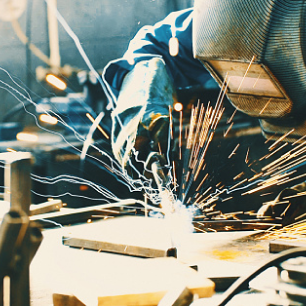Jump to:
Alternating Current Field Measurement Inspection of Storage Tanks
Storage tanks commonly found in the oil, gas, and petrochemical sector are typically constructed from welded steel plates. While the primary failure point in storage tanks is corrosion in the floor plates, inspecting welds for defects is also critical and mandatory. Detection of through-wall defects at the welds is usually carried out using vacuum box technology, although this can be difficult to deploy at complicated lap welds or near obstructions. The traditional technology for inspecting welds for non-through-wall defects is magnetic particle testing (MT), which is said to work through coatings; however, extensive surface cleaning and removal of any protective epoxy coating can be required to provide reliable results. When considering post-inspection cleaning and recoating, MT can be quite expensive and time-
consuming. Alternating Current Field Measurement (ACFM®) can be a cost-efficient and reliable method for inspecting storage tank welds to supplement corrosion mapping, and successfully detecting cracks with fast scans on coated, unprepared surfaces.
What is ACFM?
ACFM is a nondestructive examination (NDE) technology developed in response to a specific problem affecting the structural integrity of industry’s critical assets. It was initially developed in the 1990s at the University College of London (UCL) in response to major oil companies having experienced fatigue cracking of their offshore structures during the 1980s. The NDE options at the time were inefficient and unreliable for the task.
ACFM enabled fast detection and sizing of surface-breaking cracks on complex welded geometries without removing coatings. It proved forgiving enough to provide reliable inspections even in the most challenging conditions, such as underwater or rope-accessed areas. The birth of ACFM also created opportunities for better inspections in other applications, such as fatigue cracking around steel bridge welds, infrastructure inspections, and storage tanks, to name a few.
How Does ACFM Work?
The basis of the ACFM technique lies in the electromagnetic induction principle, which states that passing an alternating current in a coil generates a magnetic field around it. In ACFM probes, the field inducer coil is driven with a constant alternating current source and sits relatively high above the inspection surface — Fig. 1. It’s designed to generate uniform fields in the inspection target just below the sensors.
When scanning the probe over a crack, induced eddy currents are forced to flow under the crack and around it — Fig. 2. Those disturbances will, in turn, distort the fields above the crack where two coils are located. The Bx coil, shown in red in Fig. 2A, is sensitive to field distortions caused by eddy currents flowing under a crack. It generally results in a single half-sine signal, where the amplitude is proportional to the crack depth. This is the Bx signal. The Bz coil, shown in green in Fig. 2B, is sensitive to field distortions caused by eddy currents curving around the edges of a crack. It generally results in a single sinusoidal signal, where peaks correspond closely to the crack edges.
The crack length and depth sizing capability of ACFM relies on a simultaneous comparison of the Bz and Bx signals with a mathematical model of the interaction between a crack and the electromagnetic fields.
ACFM doesn’t rely on on-site calibrations for crack sizing. Factory calibrations are preloaded into each probe head. Most inspections are made using a carbon steel calibration on a 5 kHz probe, but austenitic alloy calibrations are also available on 50-kHz probes. A calibration remains valid whether a probe is connected to the instrument through a 5, 20, or 50 m (16.4, 65.6, or 164 ft) cable. Sizing is possible through up to 4-mm nonconductive coatings using generic probes.
An essential element of ACFM is the butterfly plot, which is obtained by combining the Bx and Bz signals — Fig. 3. The butterfly plot provides a recognizable butterfly shaped signal unique to cracks, which helps differentiate crack signals from other signals, contributing to the ease of crack detection. Crack detection is generally possible through up to 10-mm (0.4-in.) coatings using generic probes.
The same ACFM coil arrangement can be used in various probe geometries to cover most applications and is designed to provide a good balance between noise immunity and sensitivity to cracks for most welded structure inspections. The simplest single-element probe covers 15 mm (0.6 in.)wide in a single pass, and the latest-generation electronics enable fast scans while maintaining a good signal-to-noise ratio (SNR). This makes even the simplest single-element probes quite productive, as most welds can be covered in three detection scans. Detection scans count for most of the time spent running an ACFM inspection. ACFM sensors can be assembled in multielement probes to enable wider scans for more coverage and faster inspections.
Storage Tank Welding Inspection
ACFM was specifically developed to detect and size surface-breaking defects on and around rough welds through several millimeters of nonconductive coating. This is a crucial advantage because the costs associated with paint removal, post-MT reblasting, and recoating are typically four or five times more expensive than MT.
While the primary failure point in storage tanks is corrosion in the floor plates, from either the top surface or the underside, the welded sections are also a direct source of damage mechanisms.
Tank floor weld inspection can be carried out using standard, general purpose, single-sensor probes, or inspection can be sped up using advanced multisensor array probes. Standard weld or pencil probes can assess all anticipated geometries, but overall inspection speed can be improved using array probes, where possible.
Compared to MT, standard ACFM inspection with pencil probes is approximately 25% faster and 20% cheaper. For example, if we consider the inspection of both the external and internal floor-to-shell fillet welds of a 60-m (197-ft) storage tank, the MT fees for blasting, inspecting, reblasting, and recoating have a median international cost of around $15,000. The same inspection performed using pencil ACFM probes costs about $2500. While the MT takes about four to six days for the necessary preparation and post-inspection work, standard ACFM is typically done in a day. This is achieved while providing better Probability of Detection (PoD), depth sizing, and auditable records.
ACFM’s cost and productivity advantages can be further increased by using more-advanced array probes for the fillet weld. These new probes include a clever new way to estimate crack lengths that improve analysis speed and do not use moving parts.
Floor and shell joints, including lap joints, can be assessed using the high-speed ACFM array probe, which can further cut costs compared to MT — Fig. 4A. While retaining all the advantages of ACFM, these probes also feature increased crack detection and sizing performance using micro sensors instead of the usual mini sensors. The array probe can scan areas up to 90 mm (3.5 in.) wide, utilizing twin-field technology for biaxial crack detection and sizing with up to 16 individually sprung ACFM sensors. This is less fatiguing on operators, which translates into highly productive, more reliable inspections. The array probe also has an embedded position encoder to record defect locations and regulate data collection automatically. A single pass scan provides a clear view of the weld cap, toes, and heat-affected zone (HAZ) with rich information, including crack length and depth.
Modern ACFM instrumentation adds fast electronics, providing clear, high SNR signals even at high scanning speeds. State-of-the-art software and displays show clear signal representation and auditable records — Fig. 4B.
Fillet Weld Inspection
The latest ACFM technology for floor-to-wall fillet weld inspection includes multiple-element probes and the 3BZ method. These array probes enable single-pass detection and sizing of cracks in fillet welds without using an encoder. Their rugged monoblock design with no moving parts makes them suitable for difficult (and dirty) inspection environments, such as tanks — Fig. 5.
The 3BZ method (Fig. 6) enables crack length and depth sizing without encoders or marking surfaces, which is an appreciable advantage in such difficult inspection conditions. It uses two additional Bz coils per sensor for which the relative distances are known. A sizing scan performed at a reasonably constant speed will provide three Bz traces from which time measurements will be taken. Combining the known distances between the Bz coils and the time measured on the Bz signals provides an estimation of the average scanning speed. The average scanning speed and the time elapsed between the through and the peak of a Bz trace are then used to estimate the crack length and depth.
Conclusion
Although ACFM is based on the same basic physics principles as several other NDE techniques, it applies them in a unique way most adapted to the challenges of structural weld inspection. Among other characteristics, the uniform fields, the butterfly, and the sizing have been accepted for weld inspection by major organizations in the oil and gas, petrochemical, nuclear, and aerospace industries.
ACFM has received approval from several organizations, such as Det Norske Veritas (DNV), Bureau Veritas, Lloyd’s Register, and the American Bureau of Shipping (ABS). Standard practice guidelines covering ACFM include American Society for Nondestructive Testing (ASNT) E2261/E2261M-17, Standard Practice for Examination of Welds Using the Alternating Current Field Measurement Technique, American Society of Mechanical Engineers (ASME) Boiler and Pressure Vessel Code (BPVC) Section V, Nondestructive Examination, and the French Confederation for Non-destructive Testing (COFREND). Training schemes are available under the Certification Scheme for Personnel (CSWIP), Personnel Certification in Non-Destructive Testing (PCN), and ASNT. IT
CHARLES TREMBLAY (ctremblay@eddyfi.com) is product manager, PEC & ACFM®, at Eddyfi Technologies, Quebec, Canada.


